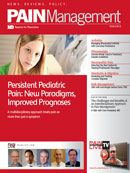Publication
Article
Pain Management
Including Low-dose Prednisone as Part of Treatment Can Benefit Patients with Rheumatoid Arthritis
Several recent studies have shown that low-dose prednisone added to methotrexate therapy can improve pain, functionality, and other outcomes for patients with rheumatoid arthritis.
Several recent studies have shown that low-dose prednisone added to methotrexate therapy can improve pain, functionality, and other outcomes for patients with rheumatoid arthritis.
The anti-inflammatory and immunoregulatory properties of the corticosteroid prednisone have long made it an important component of treatment for rheumatoid arthritis and other forms of the disease. Prednisone is often used early in treatment to alleviate the symptoms of rheumatoid arthritis until slower-acting medications have time to take effect. One strategy is to initiate prednisone therapy at higher initial doses, and then taper over the course of several days or weeks. Another is to start therapy with low doses (5-10 mg/day) and continue over the course of several weeks or months. Several recent studies have reaffirmed this approach, and demonstrated the benefits of including prednisone as part of medical treatment for rheumatoid arthritis.
Potential Side Effects Associated with Prednisone Treatment for Rheumatoid Arthritis
• Glucocorticoid-induced osteoporosis
• Increased blood pressure
• Increased blood sugar
• Greater risk of cataracts
• Avascular necrosis of bones
• Increased risk of infection
Source: http://bit.ly/xKdcFf
Patients with rheumatoid arthritis in the Circadian Administration of Prednisone in Rheumatoid Arthritis Study (CAPRA-1) were randomized to receive 2-10 mg/day of modified-release (MR) or immediate-release prednisone (IR). During the three-month double-blind phase of the trial, patients received either “IR prednisone in the morning and MR prednisone placebo in the evening, or IR prednisone placebo in the morning and MR prednisone in the evening. During the open-label extension all patients received MR prednisone in the evening.” The investigators reported that after six months of treatment morning stiffness of the joints (MS) was “reduced in the IR/MR group by 54% and in the MR/MR group by 56%.” After 12 months of treatment, MS reduction was “45% (IR/MR group) and 55% (MR/MR group).” Plasma levels of interleukin 6 declined on MR treatment, and disease activity scores were reduced “from 5.8 to 4.8 (MR/MR group) and 4.9 (IR/ MR group), respectively.” More than one-third (37%) of patients who completed the 12-month study achieved improvement according to the American College of Rheumatology (ACR20) responses criteria (http://1.usa.gov/zbalVH).
Results from the Computer Assisted Management in Early RA-II (CAMERA-II) trial presented at the ACR/ARHP 2011 Annual Scientific Meeting (http://bit.ly/w4o6v8) indicated that, after two years, patients with rheumatoid arthritis who received low-dose prednisone in addition to methotrexate therapy experienced less erosive joint damage, lower disease activity scores, and less disease related disability. Researchers also noted that a higher proportion of patients who received methotrexate plus prednisone achieved sustained disease remission (72% vs. 61%), and fewer patients treated with combination therapy required supplementation with the tumor necrosis factor inhibitor adalimumab (14% vs. 36%). Fewer patients who received methotrexate plus prednisone reported adverse events.
Horizon Pharma submitted a New Drug Application (NDA) to the FDA in September, 2011, for the delayed-release prednisone drug Lodotra, for the treatment of rheumatoid arthritis. In addition to data from the CAPRA-I study cited above, the application was supported by results from the CAPRA-II trial, in which patients who received treatment with disease-modifying antirheumatic drugs and Lodotra achieved statistically significant improvement in American College of Rheumatology 20 (ACR20) response criteria, ACR50 response, and morning joint stiffness, as well as improved ACR70 response, compared to patients who received DMARDs and placebo (http://bit.ly/ nvgPm9). In November, 2011, the FDA accepted the Lodotra NDA for filing and review, and set a July, 2012, target date for completion of the review (http://mwne.ws/z2VJFE).
Research presented at the 2010 ACR/ARHP 2011 Annual Scientific Meeting also showed that adding prednisone to methotrexate therapy could improve remission rates in patients with rheumatoid arthritis or undifferentiated arthritis. Patients in the study were treated with 25 mg per week of methotrexate and 60 mg per day of prednisone, “which was tapered down to 7.5 mg per day over the course of seven weeks.” Researchers reported that 58.6% of patients with rheumatoid arthritis achieved remission and 66.5% of participants with undifferentiated arthritis achieved remission. Participants also experienced improvements in disease activity scores and overall functionality. (http://bit.ly/x61xCw).
In another study, patients who had been diagnosed with rheumatoid arthritis within the past year were randomized to receive low-dose prednisone or placebo in addition to therapy with disease-modifying antirheumatic drugs (DMARD) and followed for two years. Patients who received treatment with prednisone achieved higher rates of clinical remission during the first year, and “showed a higher probability of sustained remission during the second year” (http://bit.ly/yDmXLv).
